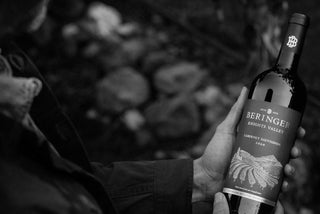Lifecycle of a Grape at Beringer Vineyards
When you indulge in a glass of Beringer wine, you are participating in a timeless process. Every sip contains the culmination of countless occurrences that took place in the vineyard. From enduring changing temperatures to undergoing crop thinning, only the most resilient grapes make it to the barrel. Read on to learn about the complete lifecycle of the grape, from bud break to bottle.

Bud Break
Springtime brings bud break and the start of a new vintage. After a long winter rest, the vines restart photosynthesis and push out small, leafy green buds. The delicate buds can be destroyed by just one night of frost, so this is a crucial time in the vineyard. Vineyard teams are on high alert and employ fans and other systems to keep frost at bay and help the nascent grapes survive their first few weeks.
Flowering & Fruit
Set In mid-April and early May, vines develop bunches of tiny flowers in a process called flowering. Each small flower has the potential to turn into a grape and is responsible for pollinating the vine’s berry seeds. After this self-fertilization, the flowers will shed their petals to make way for tiny, hard green grapes. These baby grapes will soon form bunches in a process called fruit set.
Thinning and Canopy Management
The intentional dropping of unripe grape clusters—a process known as thinning—is one of the things that sets Napa grape growing apart. With fewer grapes to tend to, the vine can send extra nutrients and water to the remaining clusters, concentrating flavors and tannins. Around this time, vineyard teams will strategically remove leaves and thin shoots to create the perfect balance of shade, sun, and air circulation around each remaining grape cluster.
Veraison
As the summer drifts on, the grape clusters will begin to change color dependent on their variety. Chardonnay evolves from green to translucent while Cabernet Sauvignon shifts from green to red. Known as veraison, this is the grape’s final transformation before harvest. Over about two months, nutrients and energy will flow from the vine’s roots to the berries, causing them to lose acidity and increase sugar levels. As the summer comes to an end, winemakers will check sugar levels, known as Brix, daily until they are just right for harvesting.

Harvest
The climax, the denouement, the grand finale; the harvest is the final step in the grape’s lifecycle. Towards the end of the summer, winemakers will start measuring sugar levels (known as brix) and other phenolic compounds until they decide the grapes have reached peak maturity. Harvest typically kicks off in early August with chardonnays and other still-white varietals. Cabernets and other red grapes will follow in the late summer and early fall months.

At the Winery
Once the grapes are harvested, they are brought back to the winery to undergo crush, fermentation, and aging. The first few days after a load of grapes is brought in happens at a furious pace. Cellar teams will sort out unripe or otherwise flawed clusters in a process called triage before crushing the grapes to separate the juice from the skins. Then, the juice is pumped into barrels or tanks to begin the fermentation process. This can vary widely depending on varietal and Winemaker Ryan Rech’s preference. As the yeasts get to work, our grape’s lifecycle concludes. Soon, the juice will make its way into barrels for aging.









